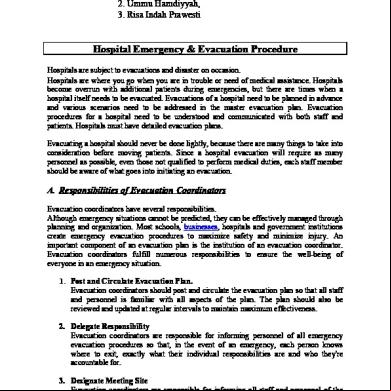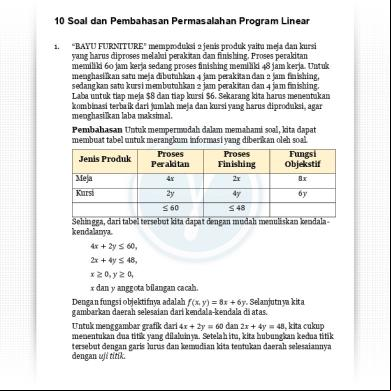Emergency Evacuation 81q66
This document was ed by and they confirmed that they have the permission to share it. If you are author or own the copyright of this book, please report to us by using this report form. Report l4457
Overview 6h3y3j
& View Emergency Evacuation as PDF for free.
More details h6z72
- Words: 987
- Pages: 27
Emergency Evacuation
Reporting
Loss
Safety Training and Procedures
Emergency Evacuation
Workplace Emergency An unforeseen situation that: Threatens your employees, customers, or the public; Disrupts or shuts down your operations; or Causes physical or environmental damage.
Reporting
Loss
Safety Training and Procedures
Emergency Evacuation
Emergencies will occur -The effect of the emergency must be controlled by means of a proper Emergency Action Plan.
Reporting
Loss
Safety Training and Procedures
Emergency Evacuation
Emergency Action Plan Its purpose is to facilitate & organize employer & employee actions during workplace emergencies. See – Emergency Action Plan Checklist (Appendix A)
Reporting
Loss
Safety Training and Procedures
Emergency Evacuation
Elements of an Emergency Action Plan Procedures for reporting emergencies; Evacuation procedures & emergency escape route assignments; information;
Reporting
Loss
Safety Training and Procedures
Emergency Evacuation
Elements continued:
Procedures for employees who remain after the alarm to perform critical duties; and Procedures to for all employees after evacuation has been completed.
Reporting
Loss
Safety Training and Procedures
Emergency Evacuation
Emergency Evacuation Plan Covers designated actions employers and employees must take to ensure employee, customer, & public safety from emergencies.
Reporting
Loss
Safety Training and Procedures
Emergency Evacuation
Elements of an Evacuation 1. Conditions for evacuation or shelter-in-place; 2. Clear chain of command; 3. Specific evacuation procedures, including routes & exits; 4. A system for ing for people after evacuation; 5. Designation of employees that will perform critical duties during an evacuation; and 6. Procedures for assisting people with disabilities.
Reporting
Loss
Safety Training and Procedures
Emergency Evacuation
1-A. Conditions for “Evacuation” Emergencies that include fires, explosions, floods, earthquakes, hurricanes, tornadoes, toxic material releases, radiological & biological accidents, civil disturbances & workplace violence may require a workplace to be evacuated.
Reporting
Loss
Safety Training and Procedures
Emergency Evacuation
1-B. Conditions for “Shelter-In-Place” Select an interior room or rooms within your facility (ones with no or few windows) & take refuge there. Local authorities may issue advice to shelter-in-place via TV or radio.
See – “Shelter in Place” Brochure
Reporting
Loss
Safety Training and Procedures
Emergency Evacuation
2. Chain of Command Authority The Coordinator is responsible for: Assessing the situation to determine whether an emergency exists requiring activation of the emergency procedures; Supervising & overseeing emergency procedures; Notifying & coordinating outside emergency services; and Directing the shutdown of utilities or plant operations, if necessary.
Reporting
Loss
Safety Training and Procedures
Emergency Evacuation
3. Specific Evacuation Procedures Routes and Exits: create maps from floor diagrams with arrows that designate the exit route assignments. Maps should include: • locations of exits; • assembly points; and • equipment that may be needed in an emergency.
Reporting
Loss
Safety Training and Procedures
Emergency Evacuation
Reporting
Loss
Safety Training and Procedures
Emergency Evacuation
4. ing for Individuals Establish: • Designated assembly areas; • Process to for employees and nonemployees such as suppliers and customers; and • Procedures for further evacuation in case the incident expands.
Reporting
Loss
Safety Training and Procedures
Emergency Evacuation
5. Designation of Employees if any, that will remain after the evacuation alarm to perform critical duties or operations before evacuating.
Reporting
Loss
Safety Training and Procedures
Emergency Evacuation
Designations & Duties Team Leader Building Coordinator Critical Operations Person Evacuation Warden
Floor Monitor Stairwell Monitor Elevator Monitor Disabilities Aide
See
Guide for Assignment of Duties/Responsibilities (Appendix B) Building Emergency Evacuation and Exit Plan (Appendix C)
Reporting
Loss
Safety Training and Procedures
Emergency Evacuation
6. Establish procedures for Assisting Visitors and Employees to evacuate, particularly those with disabilities or who do not speak English.
See – Employer‟s Guide (Appendix D)
Reporting
Loss
Emergency Evacuation
Safety Training and Procedures
Consider Everyone In The Plan
Employees Volunteers Visitors Customers/Suppliers Students Clients/Patients Hearing Impaired
Non-Ambulatory Disabled Ambulatory Disabled Non-English Speaking Vision Impaired Medical Conditions, i.e. Respiratory Impairments Cognitive/Psychiatric Impairment Others
Reporting
Loss
Safety Training and Procedures
Emergency Evacuation
„Area of Rescue Assistance‟, „Area of Refuge‟, or „Shelter-in-Place‟ An area, which has direct access to an exit, where people who are unable to use stairs may remain temporarily in safety to await further instructions or assistance during emergency evacuation.
Reporting
Loss
Safety Training and Procedures
Emergency Evacuation
Areas of Rescue Assistance Requirements:
Location and Construction Size Stairway Width Two-way Communication Identification
ADA Accessibility Guidelines for Buildings and Facilities (ADAAG) (As amended through September 2002 and Updated Guidelines (July 23, 2004) )
Reporting
Loss
Safety Training and Procedures
Emergency Evacuation
General Training for employees -address the following:
Individual roles and responsibilities; Threats, hazards, and protective actions; Notification, warning, and communications procedures; Means for locating family in an emergency
Reporting
Loss
Safety Training and Procedures
Emergency Evacuation
General Training continued:
Emergency response procedures; Evacuation, shelter, & ability procedures; Location and use of common emergency equipment; and Emergency shutdown procedures.
Reporting
Loss
Safety Training and Procedures
Emergency Evacuation
Training When to Train Employees?
Develop your initial plan;
Hire new employees; and
Annually.
Reporting
Loss
Safety Training and Procedures
Emergency Evacuation
Training continued:
Introduction of new equipment, materials, or processes into the workplace that affect evacuation routes;
Change the layout or design of the facility; and
Revised or updated emergency procedures.
Reporting
Loss
Safety Training and Procedures
Emergency Evacuation
Hold Practice Drills as often as necessary to keep employees prepared. After
each drill, gather management and employees to Evaluate the effectiveness of the drill. Identify the strengths and weaknesses of your plan & work to improve it.
Include outside resources such as Fire & Police Departments when possible.
See – Procedures for Planning & Scheduling Fire Drills (Appendix E)
Reporting
Loss
Safety Training and Procedures
Emergency Evacuation
Resources: See – Evacuation Planning Resources (Appendix F)
Reporting
Loss
Safety Training and Procedures
Emergency Evacuation
Reporting
Loss
Safety Training and Procedures
Emergency Evacuation
Workplace Emergency An unforeseen situation that: Threatens your employees, customers, or the public; Disrupts or shuts down your operations; or Causes physical or environmental damage.
Reporting
Loss
Safety Training and Procedures
Emergency Evacuation
Emergencies will occur -The effect of the emergency must be controlled by means of a proper Emergency Action Plan.
Reporting
Loss
Safety Training and Procedures
Emergency Evacuation
Emergency Action Plan Its purpose is to facilitate & organize employer & employee actions during workplace emergencies. See – Emergency Action Plan Checklist (Appendix A)
Reporting
Loss
Safety Training and Procedures
Emergency Evacuation
Elements of an Emergency Action Plan Procedures for reporting emergencies; Evacuation procedures & emergency escape route assignments; information;
Reporting
Loss
Safety Training and Procedures
Emergency Evacuation
Elements continued:
Procedures for employees who remain after the alarm to perform critical duties; and Procedures to for all employees after evacuation has been completed.
Reporting
Loss
Safety Training and Procedures
Emergency Evacuation
Emergency Evacuation Plan Covers designated actions employers and employees must take to ensure employee, customer, & public safety from emergencies.
Reporting
Loss
Safety Training and Procedures
Emergency Evacuation
Elements of an Evacuation 1. Conditions for evacuation or shelter-in-place; 2. Clear chain of command; 3. Specific evacuation procedures, including routes & exits; 4. A system for ing for people after evacuation; 5. Designation of employees that will perform critical duties during an evacuation; and 6. Procedures for assisting people with disabilities.
Reporting
Loss
Safety Training and Procedures
Emergency Evacuation
1-A. Conditions for “Evacuation” Emergencies that include fires, explosions, floods, earthquakes, hurricanes, tornadoes, toxic material releases, radiological & biological accidents, civil disturbances & workplace violence may require a workplace to be evacuated.
Reporting
Loss
Safety Training and Procedures
Emergency Evacuation
1-B. Conditions for “Shelter-In-Place” Select an interior room or rooms within your facility (ones with no or few windows) & take refuge there. Local authorities may issue advice to shelter-in-place via TV or radio.
See – “Shelter in Place” Brochure
Reporting
Loss
Safety Training and Procedures
Emergency Evacuation
2. Chain of Command Authority The Coordinator is responsible for: Assessing the situation to determine whether an emergency exists requiring activation of the emergency procedures; Supervising & overseeing emergency procedures; Notifying & coordinating outside emergency services; and Directing the shutdown of utilities or plant operations, if necessary.
Reporting
Loss
Safety Training and Procedures
Emergency Evacuation
3. Specific Evacuation Procedures Routes and Exits: create maps from floor diagrams with arrows that designate the exit route assignments. Maps should include: • locations of exits; • assembly points; and • equipment that may be needed in an emergency.
Reporting
Loss
Safety Training and Procedures
Emergency Evacuation
Reporting
Loss
Safety Training and Procedures
Emergency Evacuation
4. ing for Individuals Establish: • Designated assembly areas; • Process to for employees and nonemployees such as suppliers and customers; and • Procedures for further evacuation in case the incident expands.
Reporting
Loss
Safety Training and Procedures
Emergency Evacuation
5. Designation of Employees if any, that will remain after the evacuation alarm to perform critical duties or operations before evacuating.
Reporting
Loss
Safety Training and Procedures
Emergency Evacuation
Designations & Duties Team Leader Building Coordinator Critical Operations Person Evacuation Warden
Floor Monitor Stairwell Monitor Elevator Monitor Disabilities Aide
See
Guide for Assignment of Duties/Responsibilities (Appendix B) Building Emergency Evacuation and Exit Plan (Appendix C)
Reporting
Loss
Safety Training and Procedures
Emergency Evacuation
6. Establish procedures for Assisting Visitors and Employees to evacuate, particularly those with disabilities or who do not speak English.
See – Employer‟s Guide (Appendix D)
Reporting
Loss
Emergency Evacuation
Safety Training and Procedures
Consider Everyone In The Plan
Employees Volunteers Visitors Customers/Suppliers Students Clients/Patients Hearing Impaired
Non-Ambulatory Disabled Ambulatory Disabled Non-English Speaking Vision Impaired Medical Conditions, i.e. Respiratory Impairments Cognitive/Psychiatric Impairment Others
Reporting
Loss
Safety Training and Procedures
Emergency Evacuation
„Area of Rescue Assistance‟, „Area of Refuge‟, or „Shelter-in-Place‟ An area, which has direct access to an exit, where people who are unable to use stairs may remain temporarily in safety to await further instructions or assistance during emergency evacuation.
Reporting
Loss
Safety Training and Procedures
Emergency Evacuation
Areas of Rescue Assistance Requirements:
Location and Construction Size Stairway Width Two-way Communication Identification
ADA Accessibility Guidelines for Buildings and Facilities (ADAAG) (As amended through September 2002 and Updated Guidelines (July 23, 2004) )
Reporting
Loss
Safety Training and Procedures
Emergency Evacuation
General Training for employees -address the following:
Individual roles and responsibilities; Threats, hazards, and protective actions; Notification, warning, and communications procedures; Means for locating family in an emergency
Reporting
Loss
Safety Training and Procedures
Emergency Evacuation
General Training continued:
Emergency response procedures; Evacuation, shelter, & ability procedures; Location and use of common emergency equipment; and Emergency shutdown procedures.
Reporting
Loss
Safety Training and Procedures
Emergency Evacuation
Training When to Train Employees?
Develop your initial plan;
Hire new employees; and
Annually.
Reporting
Loss
Safety Training and Procedures
Emergency Evacuation
Training continued:
Introduction of new equipment, materials, or processes into the workplace that affect evacuation routes;
Change the layout or design of the facility; and
Revised or updated emergency procedures.
Reporting
Loss
Safety Training and Procedures
Emergency Evacuation
Hold Practice Drills as often as necessary to keep employees prepared. After
each drill, gather management and employees to Evaluate the effectiveness of the drill. Identify the strengths and weaknesses of your plan & work to improve it.
Include outside resources such as Fire & Police Departments when possible.
See – Procedures for Planning & Scheduling Fire Drills (Appendix E)
Reporting
Loss
Safety Training and Procedures
Emergency Evacuation
Resources: See – Evacuation Planning Resources (Appendix F)
Reporting
Loss
Safety Training and Procedures
Emergency Evacuation










